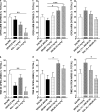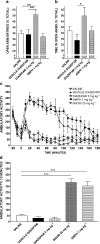Delta opioid receptor ligands modulate anxiety-like behaviors in the rat
- PMID: 16491101
- PMCID: PMC1760715
- DOI: 10.1038/sj.bjp.0706686
Delta opioid receptor ligands modulate anxiety-like behaviors in the rat
Abstract
The role of the delta opioid receptor in regulating anxiety-like behavior in male Sprague-Dawley rats was examined. Using an elevated plus maze, the effects of the selective delta opioid receptor antagonist naltrindole (1 or 5 mg kg(-1)) and agonist SNC80 (1, 5 or 20 mg kg(-1)) on anxiety-like behavior were measured. Anxiety was also measured following administration of diazepam (3 mg kg(-1)) and amphetamine (1 mg kg(-1)) and compared to the effects of SNC80. Locomotor activity following administration of naltrindole, SNC80, diazepam, and amphetamine was measured. Finally, the defensive burying paradigm was used to confirm the findings from the elevated plus maze. Results demonstrated that SNC80 produced dose-dependent anxiolytic effects similar to that of the classical antianxiety agent, diazepam. Administration of naltrindole caused anxiogenic behavior in rats further supporting the involvement of the delta opioid receptor system in regulating anxiety. Naltrindole also blocked the anxiolytic effects of SNC80. Amphetamine had no effect on anxiety-like behavior. SNC80 induced hyperactivity similar to amphetamine at the doses tested, while naltrindole and diazepam did not significantly affect locomotor activity. Although SNC80 can increase locomotor activity, control experiments reported herein indicate that hyperlocomotion is not sufficient to produce an anxiolytic response on the elevated plus maze. Together with the results from the defensive burying paradigm, this suggests that the effects of SNC80 on reducing anxiety are independent of its effects on locomotion. Collectively these data show that the delta opioid receptor system can regulate anxiety-like behavior in an anxiolytic (agonist) and anxiogenic (antagonist) manner.
Figures





Similar articles
-
The selective delta opioid agonist SNC80 enhances amphetamine-mediated efflux of dopamine from rat striatum.Neuropharmacology. 2008 Oct;55(5):755-62. doi: 10.1016/j.neuropharm.2008.06.017. Epub 2008 Jun 18. Neuropharmacology. 2008. PMID: 18602932 Free PMC article.
-
Dopamine-independent psychostimulant activity of a delta-agonist.Behav Pharmacol. 2008 Mar;19(2):113-9. doi: 10.1097/FBP.0b013e3282f62c1b. Behav Pharmacol. 2008. PMID: 18332675
-
Potential anxiolytic and antidepressant-like activities of SNC80, a selective delta-opioid agonist, in behavioral models in rodents.J Pharmacol Sci. 2004 Jul;95(3):374-80. doi: 10.1254/jphs.fpj04014x. J Pharmacol Sci. 2004. PMID: 15272214
-
Behavioral effects of delta-opioid receptor agonists: potential antidepressants?Jpn J Pharmacol. 2002 Sep;90(1):1-6. doi: 10.1254/jjp.90.1. Jpn J Pharmacol. 2002. PMID: 12396021 Review.
-
Research and development of κ opioid receptor agonists and δ opioid receptor agonists.Pharmacol Ther. 2020 Jan;205:107427. doi: 10.1016/j.pharmthera.2019.107427. Epub 2019 Oct 22. Pharmacol Ther. 2020. PMID: 31654658 Review.
Cited by
-
Stress-Induced Changes in the Endogenous Opioid System Cause Dysfunction of Pain and Emotion Regulation.Int J Mol Sci. 2023 Jul 20;24(14):11713. doi: 10.3390/ijms241411713. Int J Mol Sci. 2023. PMID: 37511469 Free PMC article. Review.
-
Effects of delta opioid receptors activation on a response inhibition task in rats.Psychopharmacology (Berl). 2011 Apr;214(4):967-76. doi: 10.1007/s00213-010-2108-0. Epub 2010 Dec 23. Psychopharmacology (Berl). 2011. PMID: 21181131
-
Anti-nociception mediated by a κ opioid receptor agonist is blocked by a δ receptor agonist.Br J Pharmacol. 2015 Jan;172(2):691-703. doi: 10.1111/bph.12810. Epub 2014 Sep 5. Br J Pharmacol. 2015. PMID: 24923251 Free PMC article.
-
Effects of chronic delta-opioid receptor agonist on the excitability of hippocampal glutamate and brainstem monoamine neurons, anxiety, locomotion, and habituation in rats.Pharmacol Rep. 2023 Jun;75(3):585-595. doi: 10.1007/s43440-023-00485-1. Epub 2023 Apr 15. Pharmacol Rep. 2023. PMID: 37060527
-
Case-control association analysis of polymorphisms in the δ-opioid receptor, OPRD1, with cocaine and opioid addicted populations.Drug Alcohol Depend. 2013 Jan 1;127(1-3):122-8. doi: 10.1016/j.drugalcdep.2012.06.023. Epub 2012 Jul 12. Drug Alcohol Depend. 2013. PMID: 22795689 Free PMC article.
References
-
- BERRENDERO F., MALDONADO R. Involvement of the opioid system in the anxiolytic-like effects induced by Delta(9)-tetrahydrocannabinol. Psychopharmacology (Berlin) 2002;163:111–117. - PubMed
-
- BILSKY E.J., CALDERON S.N., WANG T., BERNSTEIN R.N., DAVIS P., HRUBY V.J., MCNUTT R.W., ROTHMAN R.B., RICE K.C., PORRECA F. SNC 80, a selective, nonpeptidic and systemically active opioid delta agonist. J. Pharmacol. Exp. Ther. 1995;273:359–366. - PubMed
-
- BROOM D.C., JUTKIEWICZ E.M., FOLK J.E., TRAYNOR J.R., RICE K.C., WOODS J.H. Convulsant activity of a non-peptidic delta-opioid receptor agonist is not required for its antidepressant-like effects in Sprague–Dawley rats. Psychopharmacology (Berlin) 2002a;164:42–48. - PubMed
-
- BROOM D.C., JUTKIEWICZ E.M., FOLK J.E., TRAYNOR J.R., RICE K.C., WOODS J.H. Nonpeptidic delta-opioid receptor agonists reduce immobility in the forced swim assay in rats. Neuropsychopharmacology. 2002b;26:744–755. - PubMed
-
- BROOM D.C., JUTKIEWICZ E.M., RICE K.C., TRAYNOR J.R., WOODS J.H. Behavioral effects of delta-opioid receptor agonists: potential antidepressants. Jpn. J. Pharmacol. 2002c;90:1–6. - PubMed
Publication types
MeSH terms
Substances
Grants and funding
LinkOut - more resources
Full Text Sources
Other Literature Sources
Medical

